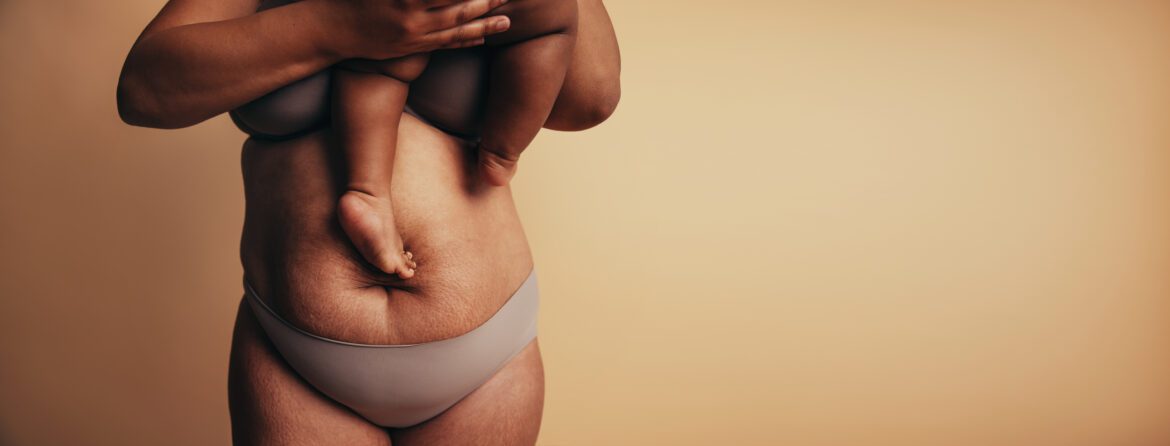Recovery after giving birth—either vaginally or by cesarean surgery—can take at least 4-6 weeks, or longer. Recovering from birthing requires time and patience as your body heals. As you embrace your post-pregnancy phase, please take time to allow yourself to heal and transition with your new baby.
Stash These Items Before Birthing
To support you during this process, here’s a list of “must have” items most nurses recommend in aiding your restoration. You may experience a wide range of symptoms during the first six weeks of your post-birth recovery. You can expect to have bleeding, perineal pain, sore nipples, fatigue, constipation, just to name a few. Stash these helpful items at home to support your recovery process.
Maternity Pads: Your uterine lining was home for baby, and it will now shed after the birth causing vaginal bleeding known as lochia. The bleeding will be like a long, heavy period, and you may bleed for 3-10 days. Some women continue to have spotting for another six weeks. You should exclusively use pads during this time as tampons can introduce bacteria into the vagina canal.
Perineal Spray: An over-the-counter local pain spray, ointment, cream, or pad will help with postpartum perineal pain. Some perineal sprays contain benzocaine, ale, lanolin, and menthol, which soothe and moisturize damaged skin.
Peri-Rinse Bottle: You will likely receive a peri-rinse bottle at the hospital; it will be helpful to keep your perineal area clean and infection-free. This is especially important if you had an episiotomy or tearing during birth. Rinsing with warm water after urination helps reduce a burning sensation some women experience, and it keeps the area clean.
Warm Bath or Sitz Bath Device: Soak in a warm bath daily for 15- 20 minutes to ease perineal pain following vaginal birth. Warm baths provide relaxation, reduce itching, and soothe soreness. Don’t have a bathtub? Use a sitz bath basin you can rest on your toilet seat filled with warm water.
Stool Softeners: You may have weakened adnominal muscles and constipation from using pain medication during or after birth. Drink plenty of water, fill up on fiber, and take short walks to get your system back on track. Perineal Cooling Pad: Apply a cooling pad to your perineum every couple of hours for the first day or two following a vaginal birth to reduce swelling and discomfort. Some perineal cooling pads absorb bleeding and don’t require freezing for use.
Overnight Nursing Bra: Wearing a well-fitted and comfortable nursing bra is an essential part of your wardrobe post-pregnancy. Cotton/spandex blend products are excellent because they’re soft and stretchy. You may want to avoid bras with hooks, plastics, or metals, to be more comfortable.
Nursing Cooling Pads: You may experience sore or cracked nipples while nursing. Using a cooling pad made for sore nipples can soothe and heal your breasts. Consider storing them in the refrigerator for added cooling comfort.
Organic Coconut Oil: Coconut oil is great for soothing sore nipples as it moisturizes irritated skin.
Recovering From Cesarean Birth
Recovering from a cesarean birth typically takes longer than from a vaginal birth. It may take at least four to six weeks at home before you feel somewhat back to normal. Stash these products for extra help and support:
Cesarean Scar Prevention: You can use creams and scar ointments to assist in reducing the appearance of your cesarean scar and promote its healing.
Postpartum Belly Binder: A belly binder can support your stomach, and the incision site, by helping decrease pain and discomfort following cesarean surgery.
Supportive Underwear: Wearing high-waisted underwear that doesn’t rub across the incision will cut down on irritation and itching in the healing scar area.
Nursing Pillow: Using a breastfeeding/chestfeeding pillow is a great way to keep pressure off your tender stomach. Additionally, consider using a nursing pillow against your incision when sneezing or coughing to provide additional abdominal support. You may also want a pillow that provides back and lumbar support, especially after cesarean surgery.
YOU MAY ALSO LIKE: Mom & Baby on the Go!: Essential Baby Gear to Get Out & About

Comments are closed.